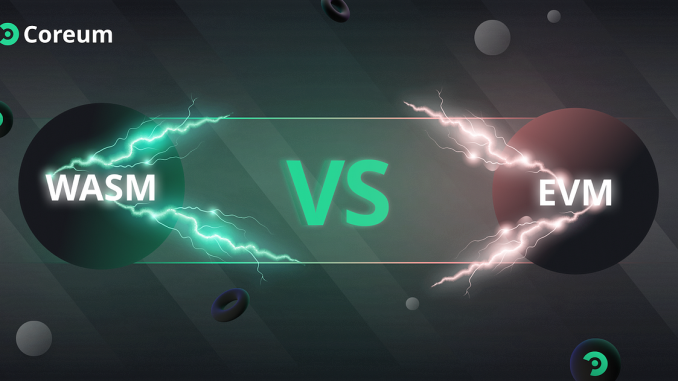
Commentary by the Coreum Development Foundation.
Blockchain technology has evolved significantly since the inception of Ethereum, introducing innovative concepts like smart contracts. Ethereum’s smart contracts, powered by the Ethereum Virtual Machine (EVM), have been a cornerstone of decentralized applications (DApps). However, with the emergence of WebAssembly (WASM), a new player has entered the field, promising enhanced performance and broader compatibility.
In this article, we’ll review the intricacies of WASM and EVM, exploring their differences, use cases, and their impact on the future of blockchain development.
Understanding EVM:
The Ethereum Virtual Machine (EVM) is a runtime environment that executes smart contracts on the Ethereum network. It uses a stack-based architecture, and every Ethereum node runs an instance of the EVM to achieve consensus on the blockchain. While EVM has been instrumental in bringing smart contracts to life, it has faced challenges, such as scalability issues, high gas fees, and limitations in terms of speed and efficiency.
WebAssembly (WASM):
WebAssembly, on the other hand, is a binary instruction format that serves as a compiler for programming languages like C, C++, and Rust. Unlike EVM, which is specific to Ethereum, WASM is designed to be platform–independent. It allows developers to write smart contracts in various programming languages, promoting flexibility and interoperability.
“A key advantage of WASM lies in the efficient execution of code, as it compiles into binaries, leading to faster performance. The goal is to achieve speeds comparable to native execution, contributing to a seamless and responsive user experience.” — Michael McCaffrey Coreum Business Development
Key Differences
In the dynamic landscape of blockchain development, both WASM and EVM play vital roles, each with unique strengths and applications. While EVM continues to be the go-to choice for Ethereum-based projects, WASM is gaining traction for its performance, flexibility, and compatibility across different blockchains.
Coreum’s utilization of WASM ensures that smart contracts are executed with enhanced speed and resource efficiency. The flexibility of WASM allows builders on the Coreum blockchain to choose from a variety of programming languages, expanding the accessibility and inclusivity of the platform; features that leading companies in the tech industry, such as Microsoft, are leveraging already.
WebAssembly made Microsoft’s Blazor framework possible by enabling C#-based web development, and now the company wants it to completely remake cloud computing — David Ramel via Visual Studio Magazine.
Ultimately, aiming to provide enterprise-grade solutions, Coreum leverages WASM and CosmWasm in a stride to deliver high-performance, secure, and flexible solutions for developers and enterprises alike.
About Coreum
Coreum, the world’s first Superledger. A 3rd-generation, layer-1 blockchain architected for enterprises of any size, from startups to large corporations. Providing a remarkable transactional speed of up to 7,000 TPS and ISO20022 compliance ensures expedient and economical transactions across a swift and secure PoS network.
As an Enterprise Graded Blockchain (EGB), Coreum introduces a new layer of programmability with ‘Smart Tokens’, enabling robust use cases through WASM-based smart contracts, including tokenized RWA’s and Neobanking applications.


